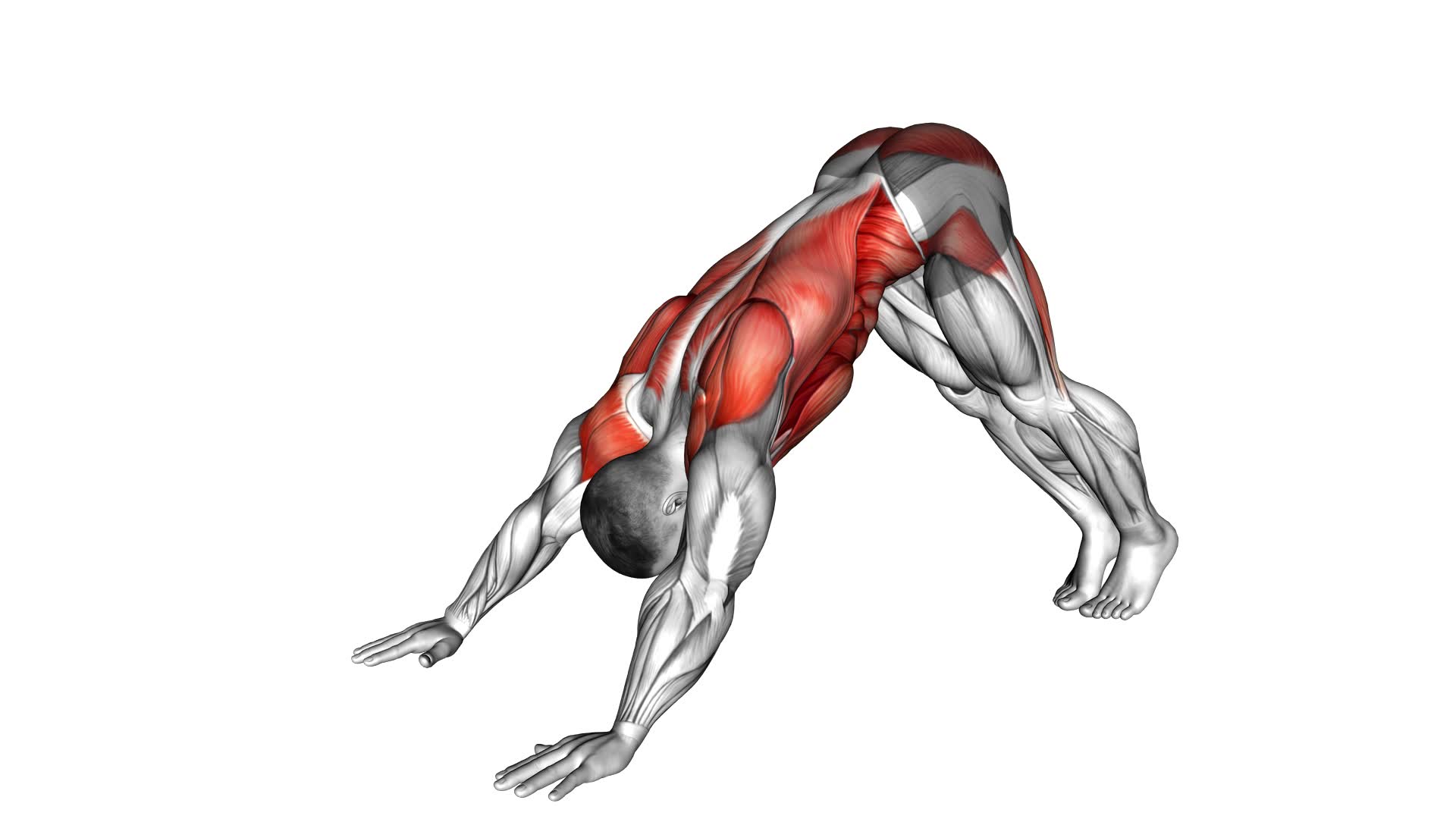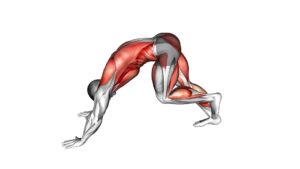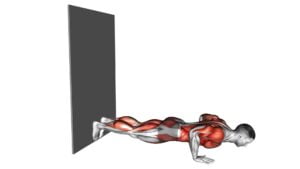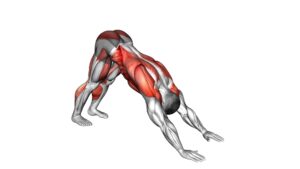Bodyweight Front Plank to Downward Dog – Video Exercise Guide & Tips

Are you looking to strengthen your core and improve your flexibility? Then the Bodyweight Front Plank to Downward Dog exercise is perfect for you!
Watch This Exercise Video
This dynamic movement targets your abs, shoulders, and hamstrings, all while increasing your overall body awareness.
In this article, we'll provide you with a step-by-step guide, common mistakes to avoid, and modifications for all fitness levels.
So grab your mat and get ready to challenge yourself with this invigorating exercise!
Key Takeaways
- The Bodyweight Front Plank to Downward Dog targets abs, shoulders, and hamstrings.
- This exercise increases overall body awareness and improves core strength and shoulder stability.
- It enhances posture and body control while reducing the risk of shoulder injuries.
- Proper body alignment and engaging core muscles are crucial for performing the exercise correctly.
Benefits of the Bodyweight Front Plank to Downward Dog
The bodyweight front plank to downward dog exercise offers numerous benefits for your core and upper body strength. By performing this exercise regularly, you can improve your body awareness and develop better shoulder stability.
Body awareness refers to your ability to understand and control the movements of your body. The front plank to downward dog exercise requires you to maintain a straight line from your head to your heels, engaging your core muscles to stabilize your body. This increased body awareness can translate into better posture and overall body control in your everyday activities.
Additionally, this exercise targets your shoulder stability. As you transition from the front plank to the downward dog position, you engage your shoulders to support your body weight. This strengthens the muscles around your shoulders, improving their stability and reducing the risk of injury.
By incorporating the bodyweight front plank to downward dog exercise into your routine, you can enhance your core strength, improve body awareness, and develop stronger shoulder stability. These benefits won't only enhance your performance in other exercises and activities but also contribute to overall strength and stability in your upper body.
Now that you understand the benefits of this exercise, let's move on to the equipment needed for its proper execution.
Equipment Needed for the Exercise
To properly execute the bodyweight front plank to downward dog exercise, you'll only need a yoga mat for added comfort and stability. This exercise can be done anywhere, making it convenient for those who prefer to work out at home or while traveling. The yoga mat will provide a cushioning effect for your hands and knees, preventing any discomfort or strain during the exercise.
While the yoga mat is the recommended equipment for this exercise, there are variations and alternative equipment options available. For example, if you don't have a yoga mat, you can use a towel or a soft blanket to provide a similar level of comfort and stability. Additionally, if you want to challenge yourself further, you can incorporate exercise variations such as performing the front plank on an unstable surface like a Bosu ball or a balance board.
Now that you know the equipment needed for this exercise, let's move on to the next section where we'll guide you through the step-by-step process of performing the bodyweight front plank to downward dog. Get ready to strengthen your core, improve your flexibility, and enhance your overall body control.
Step-By-Step Guide to Performing the Bodyweight Front Plank to Downward Dog
Now let's dive into the step-by-step process of performing the bodyweight front plank to downward dog, focusing on the execution and benefits of this exercise.
- Start by getting into a high plank position with your hands directly under your shoulders and your feet hip-width apart.
- Engage your core and keep your body in a straight line from your head to your heels.
- From here, shift your weight back and lift your hips up towards the ceiling, moving into a downward dog position.
- Keep your arms and legs straight, and try to press your heels towards the floor.
- Hold this position for a few seconds, then slowly lower your hips back down, returning to the high plank position.
- Repeat this movement for the desired number of repetitions or time.
The bodyweight front plank to downward dog exercise offers several benefits. It strengthens your core, including your abs, back, and glutes. It also improves shoulder and upper body strength, as well as stability and balance.
By combining the front plank and downward dog, you engage multiple muscle groups, making it an efficient full-body exercise. Additionally, variations of planks, such as this one, help to challenge your muscles in different ways, preventing plateaus and promoting progress in your fitness journey.
Common Mistakes to Avoid During the Exercise
To perform the bodyweight front plank to downward dog exercise effectively, it's important to pay attention to proper body alignment and engage your core muscles.
Avoid letting your hips sag or lift too high, as this can put unnecessary strain on your lower back.
Keep your shoulders stacked over your wrists and actively engage your core throughout the entire movement to maximize the benefits of this exercise.
Proper Body Alignment
Maintain proper body alignment to avoid common mistakes during the exercise.
Proper body alignment is crucial for maximizing the effectiveness of the front plank to downward dog exercise. To ensure proper alignment, start by positioning your hands directly under your shoulders and spreading your fingers wide for a stable base.
Engage your core muscles by drawing your belly button towards your spine and squeezing your glutes. Keep your body in a straight line from head to heels, avoiding any sagging or arching in the lower back. Maintain a neutral neck position by looking down towards the mat.
By focusing on proper body alignment and engaging your core muscles, you'll optimize the benefits of this exercise and reduce the risk of injury.
Stay motivated and committed to achieving your fitness goals!
Engaging Core Muscles
To engage your core muscles effectively during the front plank to downward dog exercise, focus on maintaining a strong and stable core throughout the movement. Engaging your core muscles is crucial for proper form and maximizing the benefits of this exercise.
Start by actively contracting your abdominal muscles, drawing your navel towards your spine. This will help stabilize your torso and protect your lower back. Keep your glutes engaged as well, squeezing them together to maintain a straight line from your head to your heels.
Avoid sagging or arching your back, as this can put unnecessary strain on your spine. By engaging your core muscles and strengthening your abs, you'll improve your overall stability and enhance your performance in other exercises.
Stay focused, stay strong, and feel the burn in your core!
Modifications and Progressions for All Fitness Levels
Ready to take your bodyweight exercise to the next level? This article will guide you through modifications and progressions for all fitness levels.
Whether you're a beginner looking for modifications to make the plank more accessible or an advanced exerciser seeking to challenge yourself with advanced variations of the downward dog, we've got you covered.
With these fitness level adaptations, you can continue to push yourself and achieve your goals.
Beginner Modifications for Plank
Start by easing into the plank exercise with modified versions that cater to your current fitness level. As a beginner, it's important to focus on proper form and build strength gradually.
One modification is to start with a knee plank, where you rest on your knees instead of your toes. This reduces the amount of bodyweight you have to support, making it easier to hold the position.
Another variation is the forearm plank, where you rest on your forearms instead of your hands. This reduces the strain on your wrists and allows you to focus more on engaging your core muscles.
As you become more comfortable with these modifications, you can progress to a full plank on your toes. Remember to listen to your body and take breaks when needed.
With consistency and practice, you'll be able to improve your plank and advance to more challenging variations.
Advanced Progressions for Dog
As you progress in your fitness journey, you can continue to challenge yourself with advanced progressions for the Downward Dog exercise. These modifications and variations are designed to take your practice to the next level and push your limits.
Here are three advanced modifications to try:
- One-Legged Downward Dog: From the traditional Downward Dog position, lift one leg straight up towards the ceiling. This variation not only strengthens your arms and shoulders but also engages your core and improves balance.
- Downward Dog to Plank: Begin in the Downward Dog position and then shift your weight forward into a high plank. This movement targets your entire upper body, including your arms, shoulders, and core, while also improving stability and control.
- Downward Dog Push-Ups: Start in the Downward Dog position and then lower your body towards the ground, bending your arms as if performing a push-up. Push back up to the starting position and repeat. This advanced variation increases the challenge for your arms, shoulders, and chest muscles.
By incorporating these advanced modifications and variations for advanced practitioners, you can take your Downward Dog exercise to new heights and continue to progress in your fitness journey.
Now, let's explore how to adapt these exercises for different fitness levels.
Fitness Level Adaptations
To adapt the Downward Dog exercise for all fitness levels, modifications and progressions can be made to accommodate different abilities and goals. Whether you're a beginner or an advanced practitioner, there are variations available to suit your fitness level.
If you're just starting out, you can begin by performing the exercise with your knees slightly bent or by using a block under your hands to decrease the distance between your hands and feet.
As you become more comfortable, you can gradually straighten your legs and increase the distance between your hands and feet, challenging your core and flexibility.
For those looking for an extra challenge, you can add movement to the exercise by incorporating leg lifts or knee-to-elbow touches.
Remember to listen to your body and choose the variation that feels right for you. With time and practice, you'll be able to progress and achieve your fitness goals.
Tips for Maximizing the Effectiveness of the Bodyweight Front Plank to Downward Dog
Engage your core and maintain proper alignment throughout the movement to maximize the effectiveness of the Bodyweight Front Plank to Downward Dog. Here are three tips to help you get the most out of this exercise:
- Focus on your form: The key to maximizing the effectiveness of this exercise is to ensure that your body is in the correct alignment. Start in a high plank position with your hands shoulder-width apart and your body in a straight line from head to heels. As you transition into downward dog, keep your core engaged and push your hips up and back, while keeping your heels pressed into the ground. Maintain a straight line from your hands to your tailbone.
- Breathe deeply: Deep breathing is essential during this exercise as it helps to engage your core muscles and maintain stability. Inhale deeply as you hold the plank position and exhale as you transition into downward dog. This will help you to stay focused and maintain control throughout the movement.
- Explore variations and modifications: If you find this exercise challenging, don't worry! There are variations and modifications that you can try. For example, you can perform the exercise with your knees on the ground or use a stability ball to support your upper body. As you build strength and stability, you can gradually progress to the full movement.
Frequently Asked Questions
How Long Should I Hold the Bodyweight Front Plank to Downward Dog Position?
To maximize the benefits of the bodyweight front plank to downward dog exercise, it's important to hold the position for an appropriate amount of time.
The duration will depend on your fitness level and goals.
Starting with 15-30 seconds is a good baseline, focusing on maintaining proper form and technique.
As you become more comfortable, gradually increase the time to challenge yourself.
Remember to listen to your body and progress at your own pace for optimal results.
Can I Do This Exercise if I Have Lower Back Pain?
If you're dealing with lower back pain, there are alternative exercises and modifications you can try instead of the Bodyweight Front Plank to Downward Dog.
It's important to prioritize your safety and comfort during workouts. You can consult with a fitness professional or physical therapist to find exercises that suit your needs and won't aggravate your lower back pain.
Is It Necessary to Warm up Before Performing the Bodyweight Front Plank to Downward Dog?
Before attempting the Bodyweight Front Plank to Downward Dog exercise, it's important to warm up your muscles to prevent injury and optimize your performance. Warming up has numerous benefits, such as increasing blood flow and flexibility.
If you're short on time, you can try alternatives to traditional warm-up exercises, like dynamic stretching or a short cardio session.
Can I Do This Exercise on a Yoga Mat or Do I Need a Specific Surface?
To perform the Bodyweight Front Plank to Downward Dog exercise, it's important to consider the exercise surface. You may wonder if a yoga mat is necessary or if any surface will do.
Well, let me tell you, using a yoga mat can provide extra cushioning and support for your body during the exercise. It can also help prevent slipping and provide stability.
Should I Engage My Core During the Entire Duration of the Exercise?
To get the most out of this exercise, it's important to engage your core throughout the entire duration. By doing so, you'll maintain proper form and maximize the benefits.
Keep your abdominal muscles tight and your back straight as you transition from the front plank to downward dog. This will help strengthen your core, improve stability, and enhance overall body control.
Conclusion
Incorporating the bodyweight front plank to downward dog exercise into your fitness routine can provide numerous benefits. One of the main benefits is improved core strength. This exercise engages your abdominal muscles, lower back, and obliques, helping to strengthen and stabilize your core.
Additionally, this exercise can also increase flexibility. As you transition from the plank position to downward dog, you stretch and lengthen your hamstrings, calves, and shoulders. Over time, this can lead to improved flexibility in these areas.
Another benefit of this exercise is enhanced overall body stability. By holding the plank position and then transitioning to downward dog, you challenge and strengthen the muscles in your shoulders, arms, and legs, improving your balance and stability.
It is important to remember to avoid common mistakes and make modifications as needed to accommodate your fitness level. If you are a beginner, you may need to start with modified versions of the exercise or use props such as yoga blocks for support. Listening to your body and taking it slow is key to preventing injuries and ensuring proper form.
By following the step-by-step guide and implementing the tips provided, you can maximize the effectiveness of this exercise and achieve your fitness goals. Consistency is key, so make sure to include this exercise regularly in your fitness routine.
Stay committed and motivated on your journey to a stronger and healthier body. With time and dedication, you will see improvements in your core strength, flexibility, and overall body stability.

Author
Years ago, the spark of my life’s passion ignited in my mind the moment I stepped into the local gym for the first time. The inaugural bead of perspiration, the initial endeavor, the very first surge of endorphins, and a sense of pride that washed over me post-workout marked the beginning of my deep-seated interest in strength sports, fitness, and sports nutrition. This very curiosity blossomed rapidly into a profound fascination, propelling me to earn a Master’s degree in Physical Education from the Academy of Physical Education in Krakow, followed by a Sports Manager diploma from the Jagiellonian University. My journey of growth led me to gain more specialized qualifications, such as being a certified personal trainer with a focus on sports dietetics, a lifeguard, and an instructor for wellness and corrective gymnastics. Theoretical knowledge paired seamlessly with practical experience, reinforcing my belief that the transformation of individuals under my guidance was also a reflection of my personal growth. This belief holds true even today. Each day, I strive to push the boundaries and explore new realms. These realms gently elevate me to greater heights. The unique combination of passion for my field and the continuous quest for growth fuels my drive to break new ground.







